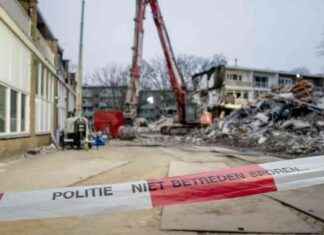In an interview with NPR, Dr. Anthony Fauci, President’s chief medical adviser, stated that “What happens in the U.K. has happened here a few days later.” “And the U.K. is experiencing a slight rebound in cases right now.”
Officials in the U.K. attribute this increase to the fast-spreading BA.2 subvariant and the widespread removal COVID restrictions as well as to waning immunity to vaccinations and infections.
Fauci says, “All three of these factors we have here at the United States.” Fauci adds that it is not surprising that we will see a plateauing in cases over the next few weeks or even a slight uptake in [the curve]”. It is possible. We’ll just have to be careful.”
The COVID tracker from the CDC shows daily cases have fallen to their lowest level since July 2021, but the rate has slowed considerably and may be poised to slow down.
A rise in viral activity at various sites across the country is also being pointed out by wastewater surveillance. Although experts caution that these data are not yet tested, they could be another sign that the U.S. may see new cases.
Amy Kirby, program leader for CDC’s National Wastewater Surveillance System detects virus fragments in feces that are flushed into sewage systems at selected wastewater treatment facilities across the country.
The waste dashboardof the CDC shows increases at around 35% of sites that monitor waste concentrations.
Kirby points out that the power of wastewater surveillance lies in its ability to provide early warning systems.
The agency stresses that the concentrations of virus RNA in wastewater are still low for now. She says that “what seemed like noise at first is now starting to look like an actual signal here at week’s end.” Consistent increases have been observed in West Virginia, Rhode Island, and Florida since the agency was established.
The wastewater system doesn’t distinguish between sublineages and omicrons, such as BA.2. Other data shows that the subvariant has taken root in the U.S. According to the CDC, it is responsible for almost 25% of all new COVID cases so far. It is concerning because it is 30% more transmissible that the original omicron and less responsive to existing COVID treatments.
According to Dr. Rochelle Walensky, CDC director, the good news is that it doesn’t seem evade our vaccinations or immunity more than the previous omicron [variant]. It doesn’t seem like it will lead to an increase in the severity of disease.
The subvariant’s effects are difficult to predict because the “landscape of immune” is dependent on time and place. Lauren Ancel Meyers, Director of the COVID-19 Modeling Consortium at University of Texas at Austin, said that it’s hard to predict the impact of the subvariant. It’s difficult at this stage to predict “whether we’re going see a wave and how deadly it will be, as well as all other things that we’d like to be able anticipate.”
The effectiveness of existing immunity and the length of time it remains after an individual has been vaccinated or boosted will have an impact on the outcome.
Officials from the health department say they are closely monitoring the signals but do not see any reason for the country to hide. ” Less that 1% of people live in areas where masking should not be advised at the moment,” Walensky stated, based upon the COVID-19 Community Level metric by the CDC, which measures the severity of disease in the area.
However, once the signs of an outbreak become apparent, it can be difficult to stop. Jeffrey Shaman, a Columbia University professor of public health, says that “the longer you wait to take action on it, then the less effective those actions are at actually preventing deaths.” Recent outbreaks have shown that “it will outpace you if it isn’t dealt with quickly and if the controls are not in place,” he said.
He said that he could see some sort of an uptick in cases in this country, based upon the U.K. situation, but it’s too early to know.
Fauci said that even if there is an increase in cases in the U.S., the BA.2 variant does not appear to be able to cause severe illness or evade vaccine protection. He says that if there is an increase in cases, it is important to be ready to pivot. Fauci also said that if this happens, “We need to be prepared to return to stricter mask mitigation if necessary.” This option, he acknowledged, can be difficult to sell to a pandemic-fatigued population.
Although the BA.2 variant may not have an adverse effect on many communities, Dr. Jeremy Luban is a University of Massachusetts virologist. He says that the more people infected, the greater chance the virus will acquire new properties and develop a new type.
Luban states that the original omicron, and now BA.2, were “relatively lucky” not to have caused as severe diseases as previous variants. Next variants might not be as kind.






